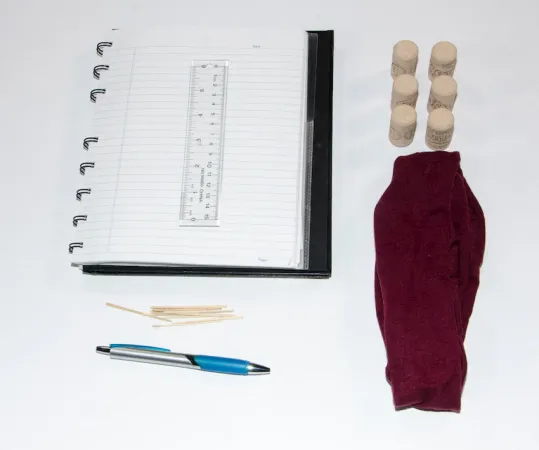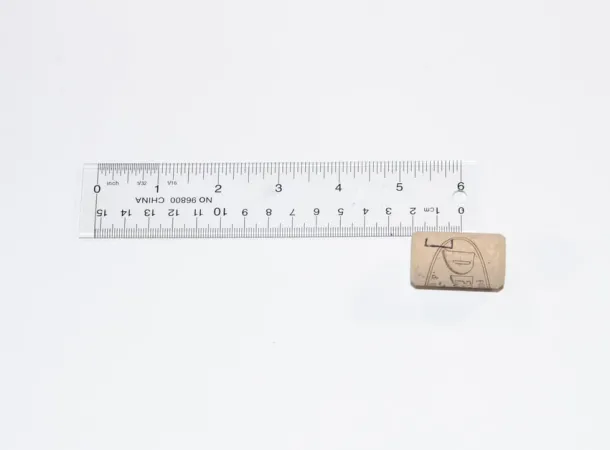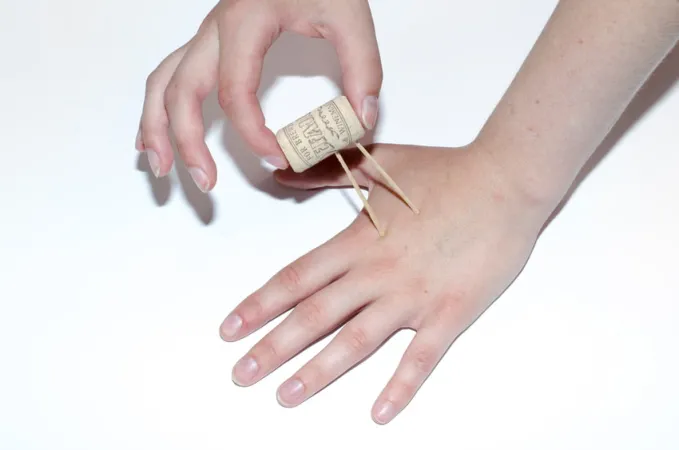
You’ve probably noticed that certain areas of your body are more sensitive than others. In fact, in some of the non-sensitive areas, you may not even be able to tell the difference between being touched by one or two toothpicks! This experiment will put your body to the test: can you tell the difference?
What you need
- 6 wine corks (or small pieces of Styrofoam)
- 13 toothpicks
- A friend
- Blindfold
- Ruler (with millimetre markings)
- Pen
- Paper
Safety first!
Be careful with the pointy edges of toothpicks – they can be dangerous when close to your eyes.
Make it
- Lay out the 6 wine corks. On the first, draw a line 5 mm long along the length of the cork. For each of the remaining corks, make the line 10 mm, 20 mm, 30 mm, and 40 mm long, respectively.
- Using toothpicks, stick one in the first cork at each end of the line. Repeat this for each cork. You will be left with one remaining toothpick.
- Blindfold your friend.
- Explain to them that you will be touching different parts of their skin, and that they need to tell you if they feel two toothpicks or one. Let them know that sometimes you will be using two and sometimes one, but that they won’t know when.
- Over the course of the experiment, randomly use the single toothpick every couple of trials, but make sure you don’t tell them that you are going to. It is important to make sure that your friend tells you that they only feel one toothpick for these trials.
Test it
Using the cork with the toothpicks that are 40 mm apart, lightly place the toothpicks on their elbow. Ask them if they felt one or two toothpicks. Record their answer. Then, repeat this process with all sizes of cork.
Repeat the above process on your friend’s knees, palms, back of hand, back of neck and forehead. Did your friend start feeling only one toothpick at a larger distance than others?
Explain it
In order to be able to perceive touches, the human body has sensory receptors that receive touch signals. Sensory neurons then conduct this signal to the central nervous system: the brain, specifically, the motor cortex. These sensory receptors, however, are not distributed evenly throughout the body; certain areas – such as the hands and lips – have nerves that are closer together than areas such as the elbows or the knees, leading them to be more sensitive.
The sensitivity of an area can be determined through this experiment, the two-point discrimination test. It’s harder for areas which have fewer sensory receptors to discriminate that there are two pressure points. So, it’s likely that your friend stopped being able to tell that there were two toothpicks at a greater distance apart for non-sensitive areas, like elbows, than for sensitive areas like the palm of your hand.
Observe it
The normal distance at which most people should be able to feel two distinct pressure points on different body parts has been studied and reported. Sometimes, this test is used in clinical settings to diagnose tactile agnosia, which is the inability to recognize objects with touch alone.
Go further
Remember how you were supposed to only use one toothpick every couple of trials? This step may have seemed irrelevant, but it did actually serve a very important purpose. Can you think of why it was included? Consider the difficulties with working with human subjects, like in this experiment, as opposed to experiments in the physical sciences.
Program Details
- View all programs at the Canada Science and Technology Museum
- View other programs related to Health & Wellness, Medicine



